Cotton trade: Spring season for the summer fabric?
As COVID-19 struck, millers have significantly cut on their demand for raw cotton as consumer interest in apparel fell sharply. But since cotton is a breathable fabric and 100% biodegradable, it serves as a good raw material for masks, which are now becoming a necessity. Also, the shocks experienced due this pandemic may prompt governments globally to shift to less-polluting industries, which might help cotton take over the market that it had lost to synthetic fibers since 2007.
- Production and consumption of cotton have declined from 6,300.89 thousand tonnes to 6,061.40 thousand tonnes and from 3,124.66 thousand tonnes to 3,079.99 thousand tonnes respectively in 2020.
- COVID-19 has hit the demand for cotton, led to the emergence of a secondary market for cheap and low-quality fiber and raw material for the mills. However, it has also ignited the demand for masks made from 100% bio-degradable and breathable fabrics like cotton.
- India is the largest producer of cotton and has a 10.8% share in world exports. The exports have declined over the last decade as China shifted its sourcing from India to duty-free alternatives like Vietnam, Pakistan, and Indonesia.
- Cotton exporters can take advantage of MAI and IES to boost their exports. The former is directed towards increasing market access and the latter is aimed at interest subvention of 3% to large exporters and manufacturers and 5% to MSMEs.
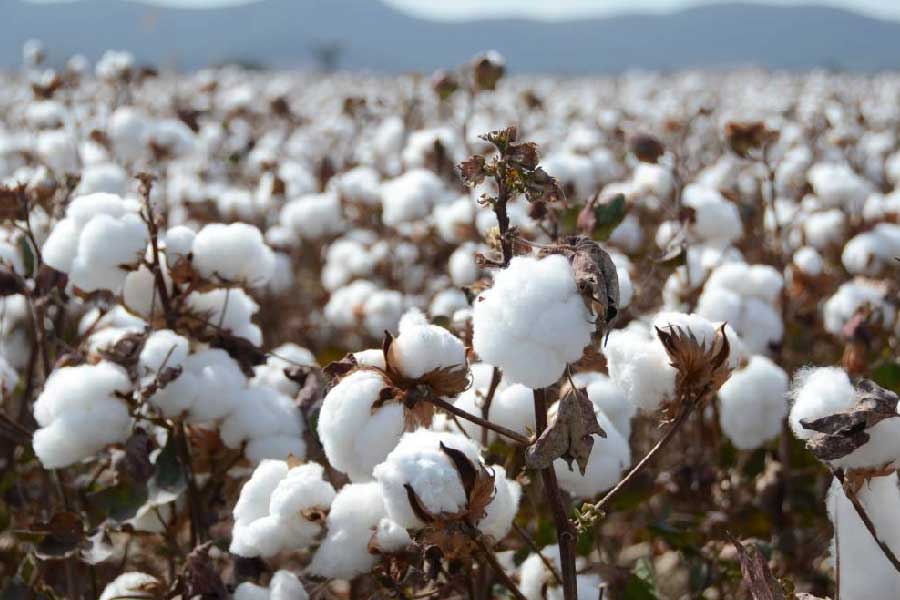
This common agricultural crop that instantly gives ‘summerish’ vibes is actually much more than just that. The natural fiber we get from the cotton plant is extremely versatile in terms of uses – it is spun into yarn to produce clothes, mats, curtains, and bedsheets, etc; the pads work as an absorbent in the medical industry, seeds are fed to ruminating animals, and are also crushed to produce cottonseed oil. The oil is used in food and cosmetics, apart from the production of plastics and rubber. Majorly grown in tropical and subtropical regions of the world, cotton is an extremely important commodity from an international trade perspective.
Global production of cotton is dominated by five countries – India, China, US, Brazil and Pakistan. China is the leading consumer followed by Bangladesh, Turkey, Vietnam, and Indonesia, where a spurt in the growth of spinning and textile mills has encouraged the consumption of cotton. This cash crop has witnessed an increase in global consumption at CAGR of 3.1% in which further expansion is expected up to 2024.
However, 2020 witnessed a decline in production as well as consumption – production is projected to fall from 6,300.89 thousand tonnes in 2019 to 6,061.40 thousand tonnes, and consumption is projected at 3,079.99 thousand tonnes in comparison to 3,124.66 thousand tonnes in 2019. The difference in demand and supply has also caused a dip in nominal as well as real prices for the crop this year from US$ 1,745.4 to US$ 1,627.3 and US$ 1,708.09 to US$ 1,554.4 respectively.
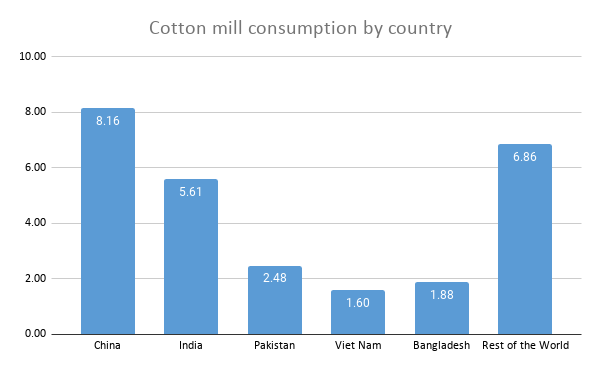
Source: OECD-FAO Agricultural Outlook 2020-2029, Figures in million tonnes for 2020
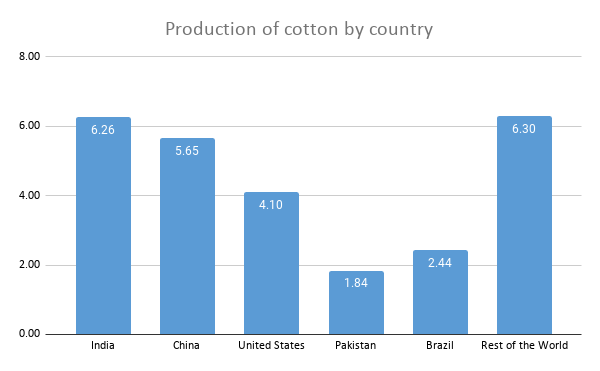
Source: OECD-FAO Agricultural Outlook 2019-2028, Figures in million tonnes for 2020
Over the years and especially post-2007, there has been a trend of slowing consumption of cotton as compared to other synthetic fibres such as polyester. This trend continued till 2012, after which a slight improvement in per capita consumption has been observed in cotton along with continuously rising demand of non-cotton fibers post-2012, which can be ascribed to per capita income growth. However, this trend is expected to change due to the COVID-19 pandemic.
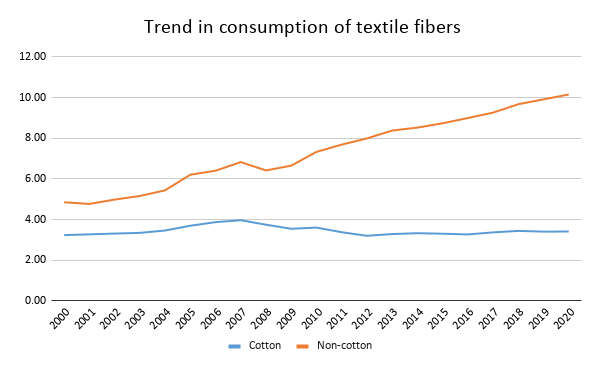
Source: OECD-FAO, Agricultural Outlook 2020-29, Figures in million tonnes
As COVID-19 struck, millers have significantly cut on their demand for raw cotton as consumers have shifted their preferences to essentials from the usual interest in apparel. As a result, mills are not interested in acquiring raw material to be woven into the yarn and fabric. Alongside this, a secondary market for recycled textiles has emerged in the world that has increased consumption of cheap and low-quality fabric, again affecting cotton.
But all this aside, since cotton is a breathable fabric and 100% biodegradable, it serves as a good raw material for masks, which are now becoming a necessity. Moreover, high-income countries that are already in favor of natural fibres will prove to be good markets for cotton. The shocks experienced due this pandemic are also serving as a wake-up call for governments globally to shift to less-polluting industries, which might help cotton take over the market that it had lost with the advent of synthetic fibers since 2007.
Indian cotton trade
India is a world leader in the production of cotton and has a 10.8% share in world exports. The main export destinations for Indian exports are Bangladesh, China, Sri Lanka, and Vietnam. Exported value in all these markets has fallen in 2019 except for Sri Lanka, where a slight and negligible increase in exports has been observed. India has been successful in maintaining the position of a net exporter over the years, though the trade balance has been on a slide.
A sharp fall of 26% in the value of exports was witnessed in 2018-19, from US$ 8.1 billion in 2018 to US$ 6 billion in 2019. China, Bangladesh and Vietnam are the main forces behind declining Indian exports to the world. Together these three are responsible for about US$ 1.5 billion decline out of total decline of US$ 2.1 billion over the 1 year. The reason mainly is China – the world’s largest importer of cotton shifted its importing market to duty-free Indonesia, Pakistan, and Vietnam due its agreements with these destinations, in contrast to Indian yarn on which 3.5% duty is levied. Such high duties have also impacted market access to the EU for cotton yarn in which Indian exports are less competitive due to higher duties as compared to the aforementioned nations and LDCs with duty-free access.
Top cotton commodities in Indian export basket
|
HS Code (6 digit) |
Product Name | Value of Exports in 2019 |
| TOTAL | All products | 323,250,726 |
| 520100 | Cotton, neither carded nor combed | 1,075,032 |
| 520523 | Single cotton yarn, of combed fibers, containing >= 85% cotton by weight and with a linear . . . | 792,327 |
| 520524 | Single cotton yarn, of combed fibers, containing >= 85% cotton by weight and with a linear . . . | 598,338 |
| 520512 | Single cotton yarn, of uncombed fibers, containing >= 85% cotton by weight and with a linear . . . | 364,645 |
| 520852 | Plain woven fabrics of cotton, containing >= 85% cotton by weight and weighing > 100 g to 200 . . . | 360,425 |
| 520522 | Single cotton yarn, of combed fibers, containing >= 85% cotton by weight and with a linear . . . | 354,722 |
Source: UN Comtrade; Figures in US$ ‘000
Schemes to promote cotton exports
The value of exports of cotton by India was highest in 2013-14, when you look a the trends over the last decade. The sector has faced multiple issues since export promotion schemes such as the interest subvention scheme (2%), incremental export incentive scheme (2%), focus market incentive (3%) that provided a competitive advantage to Indian exports were withdrawn from cotton and textile products in 2014. Merchandise Export from India Scheme (MEIS), too, is proposed to be removed in a phased manner since January 2020 as it has been found to be against the WTO rules.
The Rebate of State and Central Taxes Scheme (RoSCT), which is soon going to be replaced with the Remission of Duties or Taxes on Export Product (RoDTEP) in the upcoming months, will refund all taxes and levies not refunded under any other scheme, once it successfully replaces MEIS. However, cotton yarn and cotton fabrics are excluded from both for now.
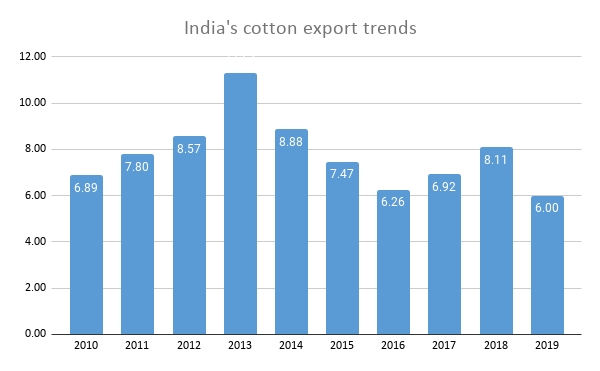
Source: ITC Trade Map, Figures in US$ billion
Exporters of cotton can avail benefits of the Market Access Initiative (MAI) Scheme which aims at increasing access to new markets or strengthening existing markets through a focus-product focus-country approach. This is applied through market studies and surveys and the Interest Equalization Scheme for pre- and post-shipment rupee export credit (IES), which was available till April 2020; but has been extended till March 31, 2021, due to COVID-19. This scheme brings the cost of credit for MSME exporters at par with the global interest rate for credit by providing interest subvention of 3% for large exporters and manufacturers, and 5% for the MSME sector.
What’s ahead for India’s cotton exports?
The Indian cotton industry needs an immediate push from the government to regain its long lost global market presence. In the short run, a safety net would help the cultivators cope with the low price received due to demand slack in order to ensure sufficient production in the next period. In the longer run, the crop faces a significant challenge on the lines of sustainability, environmental and economic impact. The current production of cotton is highly water-dependent and makes excessive use of pesticides and fertilizers along with genetic modification.
This trend needs to change for Indian farming and soil to sustain and adverse environmental impact to get mitigated. Economically, the current productivity of cotton in India is strikingly low standing at 420.72 kg equivalent to 2.47 bales per hectare. If this is increased than the scope of improving the living standards and livelihoods of the farmers will significantly improve.
The post-COVID world is expected to be more cautious and discerning towards planet earth, so cotton growers in India and everywhere else have to embrace sustainable agricultural practices. A sustainably grown cotton along with sensitisation of people and governments towards the environment might benefit the cotton growers as well as exporters due to increased demand for the natural fiber over the synthetic ones. The farmers of the crop as well as the exporters can anticipate improved living standards as well as managed soil and other resources, and the good quality product resulting from it might witness an increased demand in the future.













Hope government around the globe should listen to the wake up call and focus today cotton oriented industry. Very insightful article. Good work TPCI and Mahima